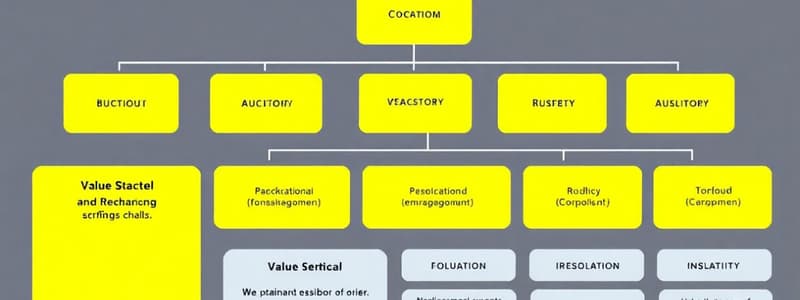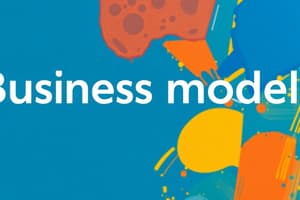Podcast
Questions and Answers
What does a business model primarily describe?
What does a business model primarily describe?
- How a business creates, delivers, and monetizes value (correct)
- The marketing and advertising plans of an organization
- The financial projections and payback analysis of a business
- The competitive strategies used by a business
Which component is essential in assessing the viability of a business model?
Which component is essential in assessing the viability of a business model?
- The structure of the governance leading the organization
- The marketing channels used to reach customers
- The value-add generated and appropriated by the business (correct)
- The compliance with industry regulations
What is the purpose of the Business Model Canvas?
What is the purpose of the Business Model Canvas?
- To develop submodels and components of a business model (correct)
- To draft a business plan for investors
- To create financial projections for the upcoming fiscal year
- To outline the competitive landscape of a sector
What does the internal component of a business model include?
What does the internal component of a business model include?
What is the primary focus of a value capturing model in a business model?
What is the primary focus of a value capturing model in a business model?
Which of the following describes the drivers of revenue in a business model?
Which of the following describes the drivers of revenue in a business model?
Why is scalability important in a business model?
Why is scalability important in a business model?
What is not a requirement for a business model to be considered viable?
What is not a requirement for a business model to be considered viable?
Which factor is NOT considered a fixed cost in a business model?
Which factor is NOT considered a fixed cost in a business model?
How does the cash flow in a typical revenue stream?
How does the cash flow in a typical revenue stream?
What primarily influences the dynamics and stability of a business model?
What primarily influences the dynamics and stability of a business model?
What is analyzed along the customer lifecycle in a value capturing model?
What is analyzed along the customer lifecycle in a value capturing model?
What is a primary characteristic of the license model in business?
What is a primary characteristic of the license model in business?
What challenge does the platform model face?
What challenge does the platform model face?
How does the relationship between potential returns and market fit work?
How does the relationship between potential returns and market fit work?
What does digitization primarily refer to in business administration?
What does digitization primarily refer to in business administration?
Which statement best describes digital business?
Which statement best describes digital business?
What is the primary purpose of multicomponent pricing models?
What is the primary purpose of multicomponent pricing models?
In the context of digital business, what is E-Commerce primarily focused on?
In the context of digital business, what is E-Commerce primarily focused on?
What do the concepts of digital business, e-business, and e-commerce reflect?
What do the concepts of digital business, e-business, and e-commerce reflect?
Which of the following is NOT an example of a multicomponent pricing model?
Which of the following is NOT an example of a multicomponent pricing model?
What is the primary goal of digitization as defined in the comprehensive construction?
What is the primary goal of digitization as defined in the comprehensive construction?
Which model relies heavily on individual customer interactions to create value?
Which model relies heavily on individual customer interactions to create value?
What characteristic defines the product model?
What characteristic defines the product model?
Which value creation model is designed to deliver customer-specific goods?
Which value creation model is designed to deliver customer-specific goods?
How would you classify a pricing model that increases in price after an initial period?
How would you classify a pricing model that increases in price after an initial period?
Which of the following models is known for having a sharp risk-return profile due to necessary development investments?
Which of the following models is known for having a sharp risk-return profile due to necessary development investments?
What does the asset model primarily rely on?
What does the asset model primarily rely on?
What does electronic commerce primarily involve?
What does electronic commerce primarily involve?
Which of the following is NOT a benefit of electronic commerce?
Which of the following is NOT a benefit of electronic commerce?
Which category best describes online sales that involve established e-tailing websites?
Which category best describes online sales that involve established e-tailing websites?
What is a significant challenge faced by electronic commerce businesses regarding customer acquisition?
What is a significant challenge faced by electronic commerce businesses regarding customer acquisition?
Which of the following is an example of a B2C electronic commerce tool?
Which of the following is an example of a B2C electronic commerce tool?
Which of the following statements about the evolution of online sales is correct?
Which of the following statements about the evolution of online sales is correct?
Which of these models represents a hybrid approach of both online and offline retailing?
Which of these models represents a hybrid approach of both online and offline retailing?
What drives the operating costs in electronic commerce?
What drives the operating costs in electronic commerce?
Flashcards are hidden until you start studying
Study Notes
Introduction to Business Models
- A business model outlines how an organization creates, delivers, and monetizes value.
- Key components involve relevant parties/relationships, as well as flows of goods, money, and information.
- Elements not considered business models include isolated pricing plans, competitive strategies, or financial models.
Business Model Canvas
- A standard framework for developing business models, aiding in designing components like procurement, value creation, finance, and revenue models.
Characteristics of a Business Model
- Viability assessment focuses on value addition through effectiveness (greater customer benefits) and efficiency (lower costs).
- Revenue sources include usage, pricing models, and network effects; costs split into fixed (assets, employees) and variable (customer acquisition, production).
- Scalability refers to a model’s capacity for growth relative to financing needs, but scalability is not a requirement for viability.
Risk Factors and Value Models
- Value capturing models relate to how businesses monetize value through customer relationships.
- Critical considerations include understanding customer profiles and revenue flow mechanisms (one-time payments, subscriptions, etc.).
Pricing Models
- Pricing strategies dictate how value is delivered to customers and directly impact income maximization.
Multi-Component Pricing Models
- Examples include printers with ink cartridges and mobile communication plans, balancing low initial costs with subsequent higher charges.
Value Creation Models
- Describe how businesses produce offerings through various supplies, featuring models like:
- Asset Model: Predictable income from production equipment.
- Product Model: Provision of standardized goods with a sharp risk-return profile.
- Service Model: Personalized service offerings that are flexible but scale slowly.
- Solution Model: Combines product and service elements for tailored goods.
- License Model: Centers on intellectual property, presenting a sharp risk-return profile.
- Platform Model: Focuses on facilitating interactions among third parties.
Digital Business Fundamentals
- Digitization involves moving processes online, enabling data to become a source of value.
- Digital Business includes e-Business and e-Commerce, involving economic activities over electronic networks.
Electronic Commerce Models
- Selling goods/services online with physical delivery highlights the core e-commerce model.
- Examples include B2B tools and international online retailers, contributing value through convenience.
- E-commerce dates back to 1994, with the business model remaining consistent despite technological advancements.
Maturity Stages of Online Sales
- Online Sales 1.0: E-tailing and booking platforms.
- Online Sales 2.0: Shopping clubs and subscription models.
- Online Sales 3.0: Omnichannel management practices.
Electronic Commerce Retailing Models
- Three categories of retailers defined, reflecting a shift towards online strategies.
Front-End Core Process in E-Commerce
- Revenue generation hinges on site visitor attraction and conversion to buyers via various marketing channels.
Customer Acquisition Costs (CACs)
- CACs tend to increase disproportionately as the number of acquired customers rises.
Studying That Suits You
Use AI to generate personalized quizzes and flashcards to suit your learning preferences.




